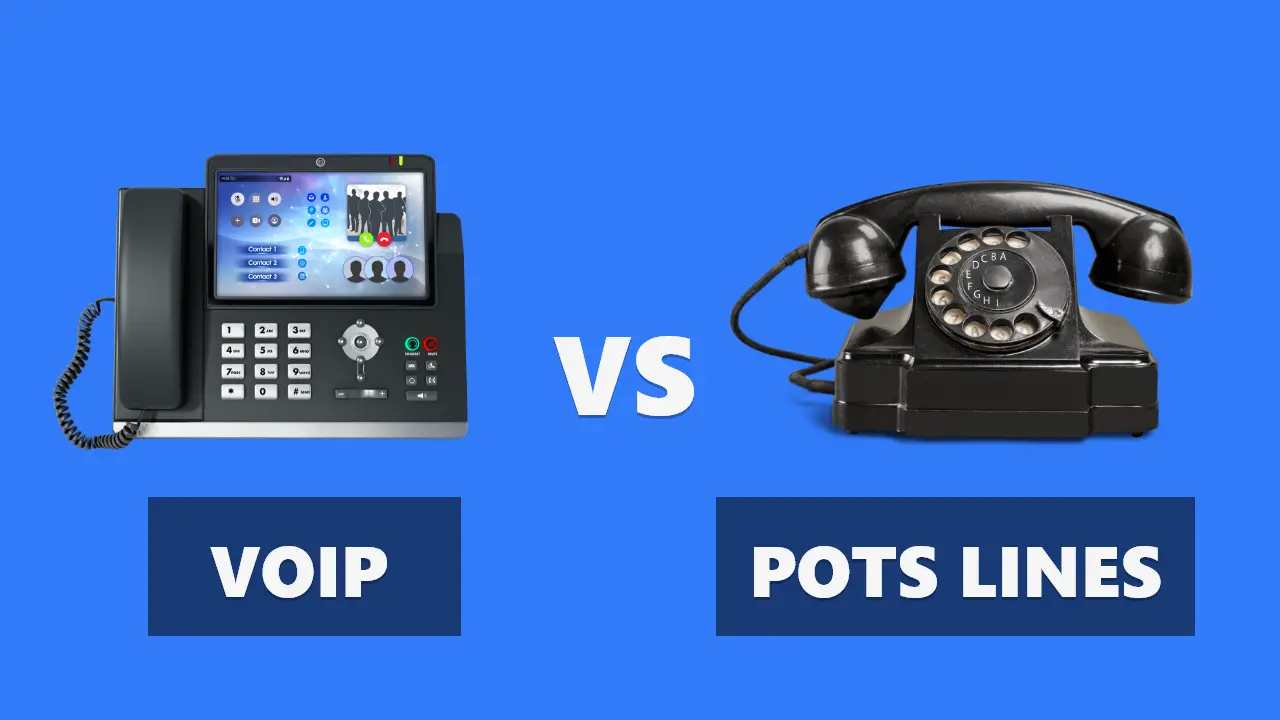The telecommunication world used to be much simpler, but with technological advancements, phone systems have also become advanced. Today, businesses have numerous options for choosing their phone system. Within these options are VoIP and POTS. All businesses are looking for communication systems that can help them improve customer experience and increase revenue.
Although both VoIP (Voice over Internet Protocol) and POTS (Plain Old Telephone Service) come with their benefits and can be suitable for your business, it is important to understand their differences to choose one that matches your business requirements.
To help you out, we will explain the differences between VoIP and POTS and what each can deliver at the enterprise level. But before getting into VoIP Vs POTS, let’s look at each service individually.
Understanding Voice Over Internet Protocol (VoIP)

VoIP is a phone service that transmits voice data over an internet connection. In other words, this phone system virtually makes voice calls through the internet instead of using traditional phone lines. It means all your communication will take place over the internet.
Typically a VoIP service is set up using a hosted Private Branch Exchange (PBX), but now cloud-based phone systems are also used to set up VoIP service. In addition, you can get this service with an on-premise PBX system, and this type of VoIP service is called SIP trunking.
Since a VoIP phone system entirely depends on an internet connection, it is necessary to have an internet connection with high speed, bandwidth and low latency. According to the experts, small businesses must have a minimum of 5 Mbps upload and download speed to get a high-quality service. For large offices, it is recommended to get a custom design to ensure a high quality of service (QoS).
In addition, one good thing about VoIP is that it employs CODECS allowing users to transmit different types of data other than voice transmission. It includes video calling and sending multimedia files or images.
Benefits Of VoIP for Businesses
Apart from providing cost benefits to businesses, VoIP has the upper hand compared to other phone systems due to the following benefits:
1. Increased Productivity With Unified Communication
VoIP phone systems allow you to communicate with your team, clients or customers on call or messages without switching to any other application. It is a unified communication system perfect for streamlining your business communication.
Furthermore, it can collaborate with business applications such as CRM and email. You can improve overall productivity by managing all your business operations on a single platform.
For instance, when you integrate CRM with VoIP, you can see all the client’s data on your computer screen whenever a call comes in.
2. Convenience Of Remote Access
VoIP offers flexibility and mobility similar to the mobile user experience. It does not bind users to their office desks to make or receive calls. You can install a VoIP app on your computer, laptop or any mobile device and use it anywhere with internet access.
VoIP can be easily used over hard phones, softphones or video conferencing equipment. VoIP phones are not linked to a person using them and are not bound to a single location.
Such features allow your employees to remain productive irrespective of their location, and they can enjoy the facility of remote work whenever they want.
3. Advanced Features Without Added Cost
When using a traditional phone system, you must pay to add any feature whenever you want. In contrast, switching to VoIP phone service comes with pre-included features such as call transfer, DND abilities, call forwarding and auto attendant.
You do not need to pay for features that come with standard packages; these features are usually enough and highly beneficial for startups and small businesses.
4. Easy Scalability
Another significant benefit of VoIP is its immense scalability. The traditional analogue phone system tends to be more expensive when your business grows as you have to get a separate phone line for each employee.
You must also spend money to purchase the physical equipment required to scale up your traditional phone line system.
On the other hand, VoIP allows you to scale up your business without spending money on additional equipment.
You can add more numbers and extensions when your business requirements grow. In addition, you can save money on maintenance costs and use it for other business operations.
Understanding Plain Old Telephone Service (POTS)

We all know POTS as a landline telephone system in our homes while we are growing up. However, it is usually defined as an analogue voice transmission system that uses copper wires.
These copper caves help in transmitting voice from one place to another. They facilitate communication worldwide with their complex network that has navigated to reach even some of the remotest locations.
Since its emergence, there has been little modification to the POTS system, and even today, it works by creating a dedicated circuit between two points during transmission.
POTS must have open circuits that must remain open so that the analogue signals can be sent directly to the device. These phone lines convert voice signals into electrical waves and again into voice signals at the receiver’s device. It may seem complex but the whole princess takes place simultaneously.
Benefits Of POTS Line
Traditional phone systems may not be able to compete with advanced communication technologies like VoIP. Still, it has certain advantages that make it difficult for users to switch to a modern communication system.
Some of the advantages that POTS provide are as follows:
1. Well Established Technology
The traditional phone system use has certainly undergone several changes since Alexander Graham Bell first introduced it. This technology has been in the market for a long time, so it is well-established. It is supported by a wee-spread network of cables worldwide connecting location that seems unapproachable.
Analogue endpoints may not always be relevant, but for now, this technology is well understood and is seen as a preferred means of communication, even at the commercial level.
2. Ease Of Use
Landline or POTS are among the easiest services to get installed. It is a 2-wire telephone service that is free of any complexity regarding installation and use.
It is also because it lacks advanced features like VoIP or other internet-based communication technologies.
3. No Need For Power
One of the important advantages of POTS over VoIP is that you can continue your business communication even if there is a power outage. The carrier provides the power required to run the landline connection instead of the end user.
So even if your building loses power due to heavy rain or any other circumstances, your telephone line will continue working, and it’s particularly useful for 911 emergencies.
4. Special Uses Of POTS
In this modern era, POTS is still used for specific uses, such as fax, elevator, and emergency phone services.
Even today, some local codes may also need your business to have a landline for handling emergencies.
VoIP Vs POTS
From the above discussion, we can say that POTS is an analogue system while VoIP is its digital equivalent. Instead of having unique advantages, POTS is losing its market, and VoIP is taking over it. However, comparing these communication systems based on technology is not fair.
VoIP is a communication system designed to facilitate integrations of business apps that always run on the internet. In contrast, POTS was built when the infrastructure and technologies were not advanced. So, here we will compare VoIP and POTS in terms of cost and find whether it is reliable for your business.
- When we make a cost comparison, VoIP is a clear winner because it works on a subscription model, while POTS charges depend on the number of users who want to make a call simultaneously.
- Making an international or long-distance call with a traditional phone line can cost a lot, but VoIP lets you make international calls at lower rates.
- Moreover, it requires more cost to set up as it needs more hardware to function. VoIP can help you in reducing this hardware setup and maintenance cost.
- VoIP allows the integration of different business applications like CRM, messaging and email, making it easier for employees to work remotely. It is a more reliable communication method than POTS and does not require any additional device for employees to get remote access.
- VoIP uses an existing internet connection that is a part of most businesses today. Only a few organizations can hope to function without an internet connection. Thus we can say that VoIP is a logical extension of this existing setup.
VoIP Or POTS Which One Is Right For Your Business?
VoIP and POTs both have their benefits and drawbacks. You must determine your business requirement and budget before making a final decision.
Due to new technology, many users think that VoIP is a complex system and do not adopt it. POTS is easier to use, but VoIP provides numerous benefits that are enough to outweigh the convenience of the use of a traditional phone system.
Moreover, advanced technologies like VoIP are taking over older systems because it is difficult for users to upgrade existing devices or spend money on the maintenance of huge hardware setups.
Lastly, the cost is one of the significant reasons businesses are adopting VoIP instead of using traditional landlines. So, we can say that advanced technology is better in every aspect.
Conclusion - VoIP Vs POTS Lines
VoIP (Voice over Internet Protocol) and POTS (Plain Old Telephone Service) are two types of phone systems that differ in transmitting voice calls. VoIP makes voice calls using the internet instead of traditional phone lines. It can transmit data other than voice, such as images and videos.
VoIP is a cost-effective phone system that can be scaled up easily, provides advanced features, and can increase productivity by integrating with other business applications.
On the other hand, POTS is an analogue voice transmission system that creates a dedicated circuit between two points during transmission. It uses copper wires to transmit voice signals, converts them into electrical waves, and then back into voice signals.
We hope that you will find our VoIP Vs POTS comparison helpful and that it will help you choose the right telephone system for your business.




